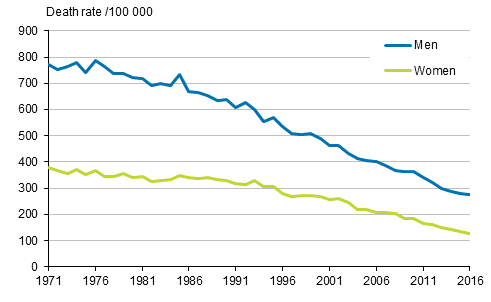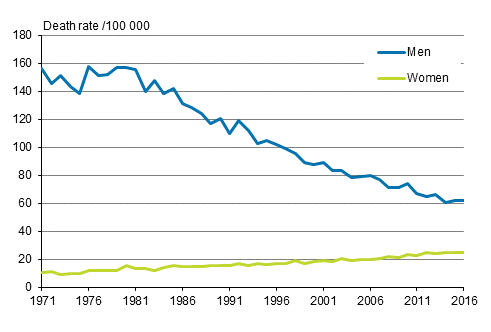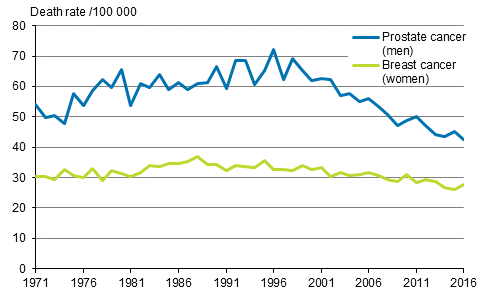2. Ischaemic heart disease mortality decreased further
Of the main cause of death categories, most Finns died of diseases of the circulatory system in 2016. The group’s importance as a cause of death has decreased, however, over the past twenty years from 45 to 36 per cent. Simultaneously, men's and women's age-standardised mortality from diseases of the circulatory system has decreased by over 40 per cent. In 2016, mortality from diseases of the circulatory system decreased for women and remained on the same level as the year before for men (Appendix figure 1).
Among diseases of the circulatory system, ischaemic heart disease is still one of the most common causes of death for Finns, even though mortality from ischaemic heart disease has decreased clearly in Finland. Ischaemic heart disease still caused every fifth death and over 10,000 persons died of it in 2016.
Persons dying of ischaemic disease older than before
Persons dying of this disease are ever older. In 1971, nearly four out of ten persons that died of ischaemic heart disease were of working-age, while in 2016 only one in ten was of working-age. The median average age for those dying of ischaemic heart disease in 1971 was 65 years for men and 73 years for women, while the corresponding figures in 2016 were 79 and 87 years.
Figure 3 shows age-standardised ischaemic heart disease mortality. In age standardisation, the effect of the age structure of the population and its changes are eliminated. Then it is seen at which level mortality from ischaemic heart disease would be if the age structure of the population remained unchanged during the whole reference period. The new standard population of Eurostat is used as the standard population in age-standardisation. When the ageing of the population is eliminated from the figures by age standardisation, it can be seen that ischaemic heart disease mortality has fallen evenly over the last 40 years. In 2016, ischaemic heart disease mortality decreased further for both men and women.
Figure 3. Age-standardised mortality from ischaemic heart disease in 1971 to 2016

Women's lung cancer mortality has grown by one-fifth in ten years.
Of the main cause of death categories, second most Finns died of neoplasms. In 2016, they caused nearly one in four deaths. Persons who died of neoplasms were on average almost 10 years younger than those who died of diseases of the circulatory system. Over the past ten years, age-standardised neoplasm mortality has decreased by over ten per cent for men and less for women, that is, by two per cent (Appendix figure 2). In 2016, neoplasm mortality decreased a little further for men and for women it grew by two per cent from the year before. The most common type of cancer resulting in death was lung cancer for men and breast cancer for women.
In 2016, around 1,500 men and 800 women died from carcinoma of the larynx, carcinoma of the tracheitis and lung cancer. The difference between men and women in lung cancer mortality has narrowed since the 1980s as men’s lung cancer mortality has decreased while it has grown among women. Over the past ten years, women’s age-standardised lung cancer mortality has grown by more than 20 per cent and men’s has decreased by as much. In 2016, lung cancer mortality remained at the same level as in the year before for both men and women (Figure 4).
Figure 4. Age-standardised mortality from carcinoma of larynx, trachea and lung in 1971 to 2016

The most common type of cancer causing death among women is breast cancer. In 2016, altogether 874 women died from breast cancer, which was around 60 more than in the year before. Breast cancer mortality was 31 deaths per 100,000 women. The average age of persons that died of breast cancer was 71 and one third were aged under 65. In 2016, the number of deaths from breast cancer was nearly the same as ten years earlier but age-standardised breast cancer mortality has decreased by over ten per cent (Figure 5).
After lung cancer, prostate cancer is the second most common type of cancer resulting in death among men. In 2016, altogether 888 men died from prostate cancer, which was nearly as many as women who died from breast cancer. Men’s prostate cancer mortality is almost on level with women's breast cancer mortality, that is, 33 deaths per 100,000 men.
Above all, prostate cancer is a common cause of death for aged men: more than nine out of ten of the deceased were over 65 and the average age of the deceased was 81. Men's age-standardised prostate cancer mortality has decreased clearly in the 2000s.
Figure 5. Age-standardised prostate cancer mortality for men and breast cancer mortality for women 1971 to 2016

Source: Causes of death, Statistics Finland
Inquiries: Airi Pajunen 029 551 3605, Jari Hellanto 029 551 3291, Kati Taskinen 029 551 3648, kuolemansyyt@stat.fi
Director in charge: Jari Tarkoma
Updated 29.12.2017
Official Statistics of Finland (OSF):
Causes of death [e-publication].
ISSN=1799-5078. 2016,
2. Ischaemic heart disease mortality decreased further
. Helsinki: Statistics Finland [referred: 19.4.2025].
Access method: http://stat.fi/til/ksyyt/2016/ksyyt_2016_2017-12-29_kat_002_en.html

